This is known as content syndication.
In this article, you’ll learn:
- What content syndication is
- The benefits of content syndication
- The differences between syndication, repurposing, and guest blogging
- How content syndication affects SEO
- How to get started with content syndication
- Paid and self syndication
- How to go beyond syndication
Content syndication is when one or more third-party sites republish an exact copy of content that originally appeared elsewhere.
For example, James Clear first published a post about deliberate practice on his blog.
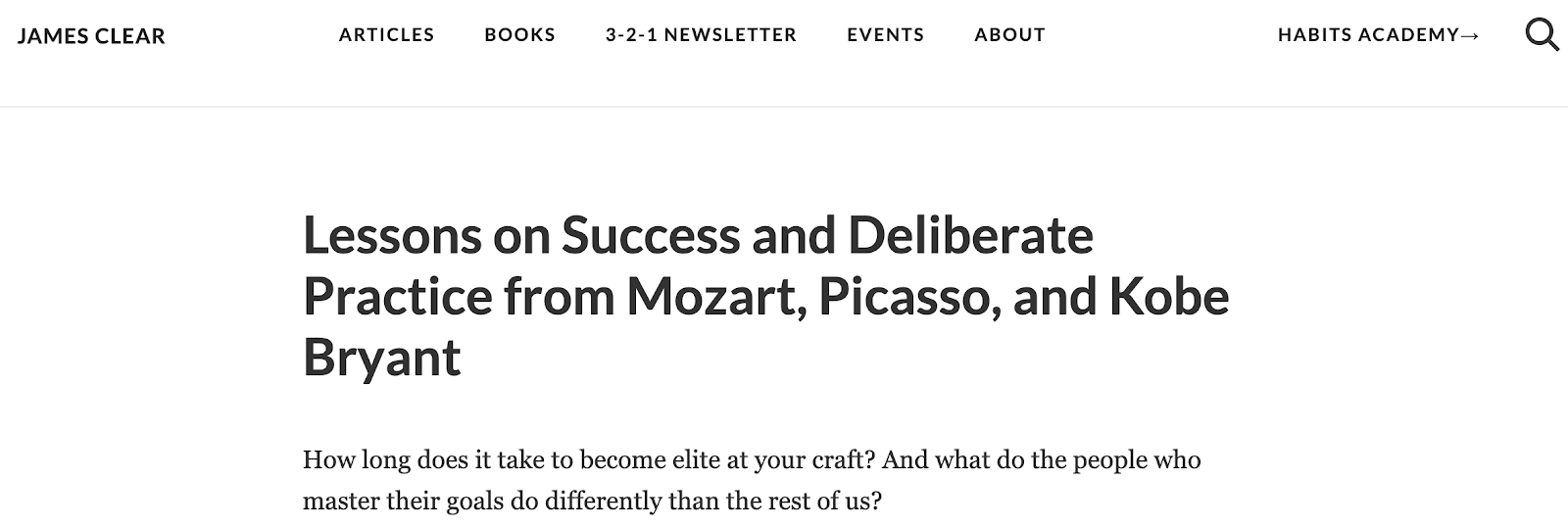
Later, Lifehacker republished the same article.

Besides getting more eyeballs on your content, there are tangible business benefits to syndication too.
Get referral traffic
Most websites that republish your content tell their readers where it originally appeared—and link to the original source.
If readers enjoy the syndicated piece, they may click through to your website for more.
This is how James Clear got tons of referral traffic to his site; he was syndicating to Lifehacker.
Get email subscribers
Sarah Peterson accumulated over 1,000 new subscribers by republishing her article on EliteDaily.
She did this by getting the editor to allow a link back to her course in her bio.
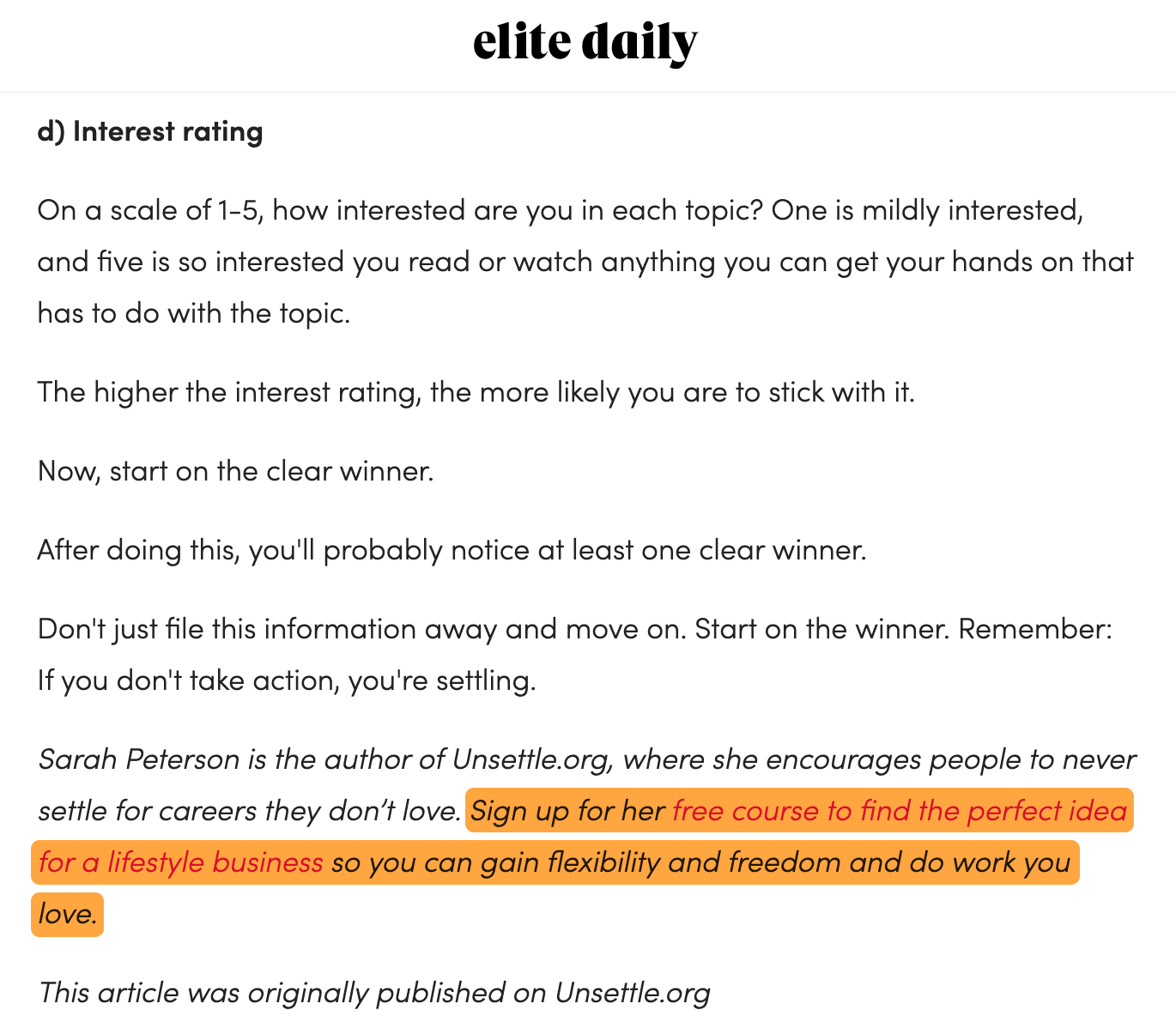
Build your brand
When people see your brand or name consistently on authoritative sites, it creates a halo effect. They will start to see you as authoritative too.
Plus, because of the mere exposure effect, people who see your brand more often are more likely to buy your product in the future.
What’s the difference?
Repurposing
Content repurposing is when you find a new use for your existing content.
For example, you might want to convert a video you produced into a blog post or vice versa.
We do that pretty often here at Ahrefs. As an example, we repurposed our post on video SEO into a video:
Guest blogging
Guest blogging is when you create an entirely new piece of content for a specific site.
Here’s one I published on SmartBlogger recently:

Note that I wrote this specifically for this site. I didn’t post it anywhere else.
Content syndication
Content syndication is more of a distribution tactic than anything else. You publish something on your website, and it gets republished word for word elsewhere.
Take a look at these two posts, for example—they’re the same:


This is what makes content syndication a scalable distribution tactic. You don’t have to spend time repurposing or rewriting to reach a new audience.
Some people worry that syndicating their content will cause duplicate content issues and result in a Google penalty.
There’s some logic behind this idea, as duplicating content across domains can be a spammy tactic, which Google points out here:
In some cases, content is deliberately duplicated across domains in an attempt to manipulate search engine rankings or win more traffic. Deceptive practices like this can result in a poor user experience, when a visitor sees substantially the same content repeated within a set of search results.
But Google also understands that content often appears on more than one site for legitimate reasons, as is the case with content syndication.
You’re not trying to manipulate the results and rank your content multiple times; you’re just trying to get more eyeballs on your content by tapping into other sites’ audiences.
Google has developed ways to account for this and has confirmed that there’s no such thing as a duplicate content penalty.
DYK Google doesn’t have a duplicate content penalty, but having many URLs serving the same content burns crawl budget and may dilute signals pic.twitter.com/3sW4PU8hTi— Gary “鯨理/경리” Illyes (@methode) February 13, 2017
That said, syndicating content can lead to some issues, like Google ranking a syndicate over the original.
This doesn’t often happen because Google has algorithms in place to identify duplicates, cluster them together, and identify the original—which it then ranks for relevant terms.

Problems only occur when Google’s algorithm incorrectly identifies a duplicate as the original.

Generally speaking, this rarely happens unless you’re a tiny site syndicating to big publications. So, while it’s not a huge worry, it is something to be aware of.
Google used to recommend adding a canonical link back to the original article to prevent this. Now, they recommend that the syndicated article be blocked from indexing. The problem is that publishers have to agree to that, and many agreements don’t allow it. I would try to follow their advice, and use a canonical if you can’t.
Follow these three steps:
Step 1: Create great content
Publications make money off advertising. More page views mean more advertising revenue.
Syndication allows them to take advantage of content that is already proven to generate eyeballs, or at least allows them to take a bet on a writer who can.
So, what publications lack is not free content, but great content.
Therefore, to get syndicated, you need to lay the groundwork and create noteworthy content.
How? That’s an entire article on its own, but this video should get you on the right track:
Step 2: Find potential syndicates
Once you have a good reputation for creating awesome content, you’ll need to find sites willing to republish it.
Here are a couple of ways to find them:
A. Use Google
If publications have syndicated content from others, they’re more likely to be receptive to republishing content from you.
Typically, these publications link back to the original articles using a few similar phrases, like:
- Republished with permission
- Originally appeared on
- Originally published on
You can take advantage of that by combining phrases with Google search operators to find syndication opportunities.
For example, you can search “originally appeared on” + [topic] to find sites that have republished content before.

You can also install Ahrefs’ SEO toolbar to quickly spot relevant, authoritative (high Domain Rating) sites where you might want to syndicate content.
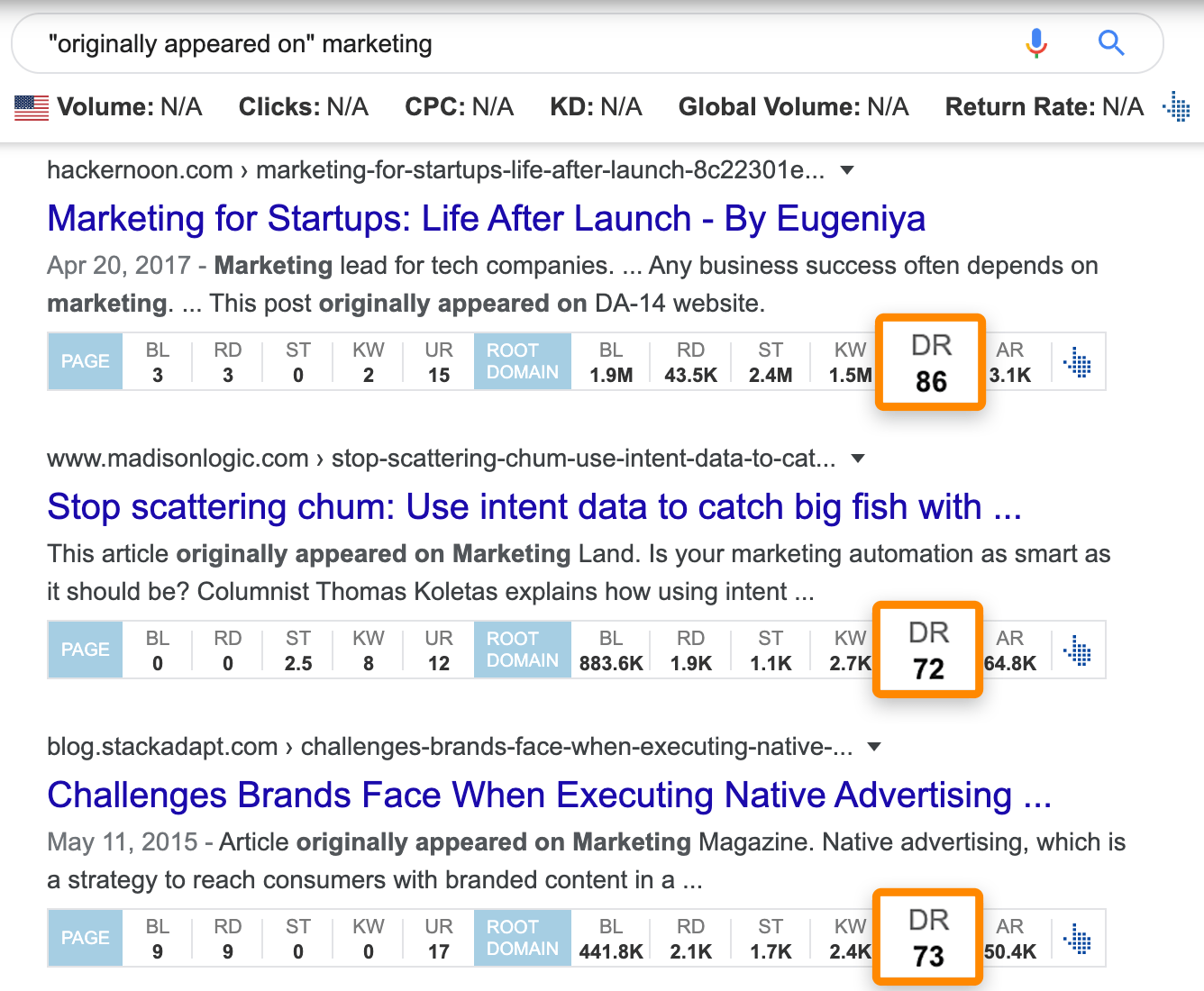
This tactic is also useful if you have a publication in mind, but you’re not sure if they publish syndicated content. You can figure this out by doing a search for the footprint + site:domain.com.

B. Use Site Explorer
If you’ve already seen an author’s content syndicated on a couple of sites, chances are they’re syndicating to other places too.
To find these, paste the author’s site into Ahrefs’ Site Explorer, go to the Backlinks report, then enter one of the footprints above in the “Include” box. This will surface sites that have republished content from your target domain.
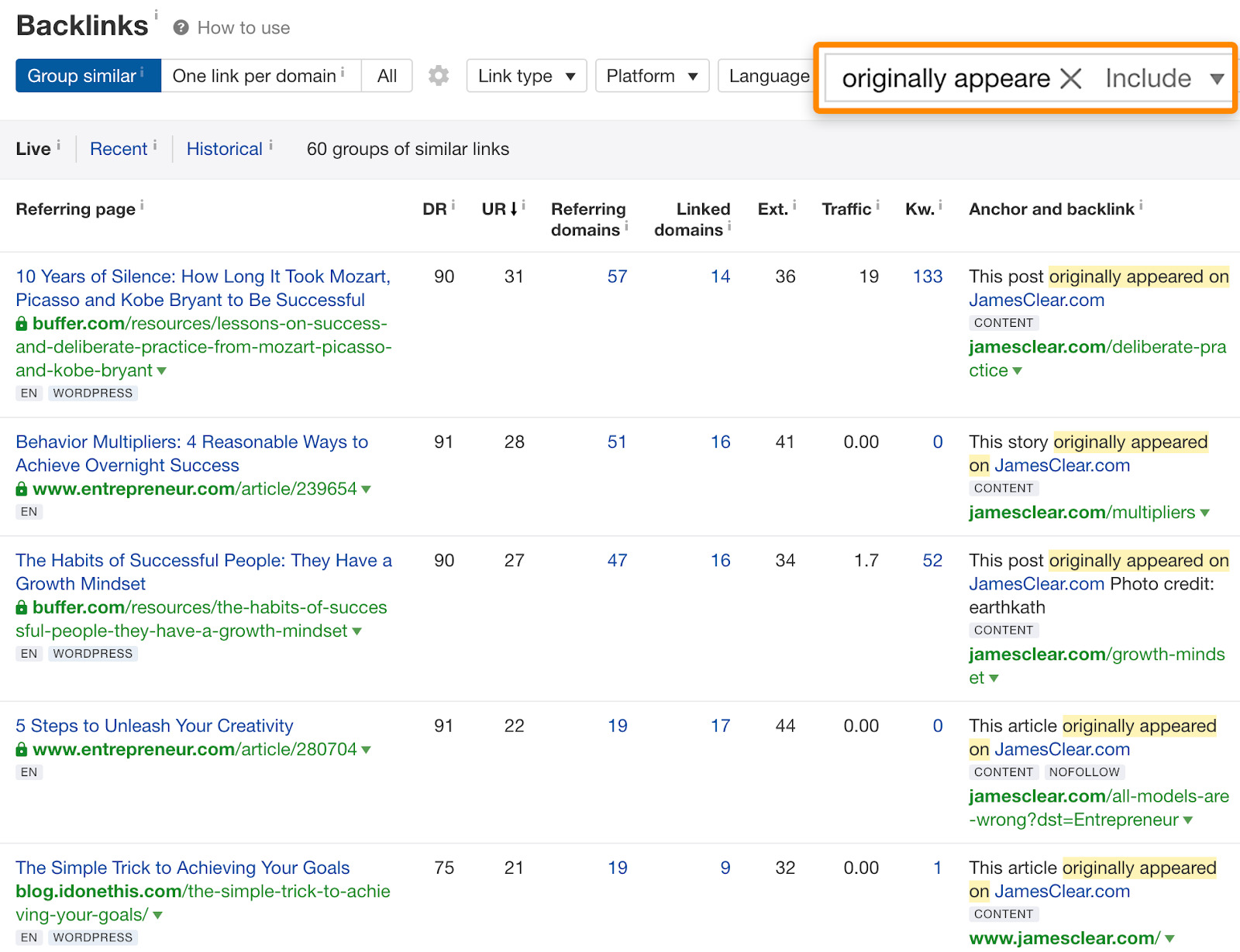
Note down relevant and popular sites that you might want to syndicate content to.
Step 3: Reach out and negotiate
Find the name and email address of the website owner or editor, then reach out and ask if they’d be open to syndicating your content.
Just remember that big sites have different journalists for different topics, so make sure to do your research and reach out to the right person.
Reaching out to publications and asking them to republish your content isn’t your only option. You can also pay for syndication or self-syndicate.
Paid syndication
Paid syndication is where you spend money to place your content on large publications.
For example, platforms like Outbrain and Taboola place links to your content at the end of editorial content, usually on notable publications like The Guardian.

If you’re familiar with Facebook ads, you’ll be pleased to know that setting up a paid syndication campaign is relatively similar. Sign up, choose your campaign objectives, budget, where you want to target, etc.
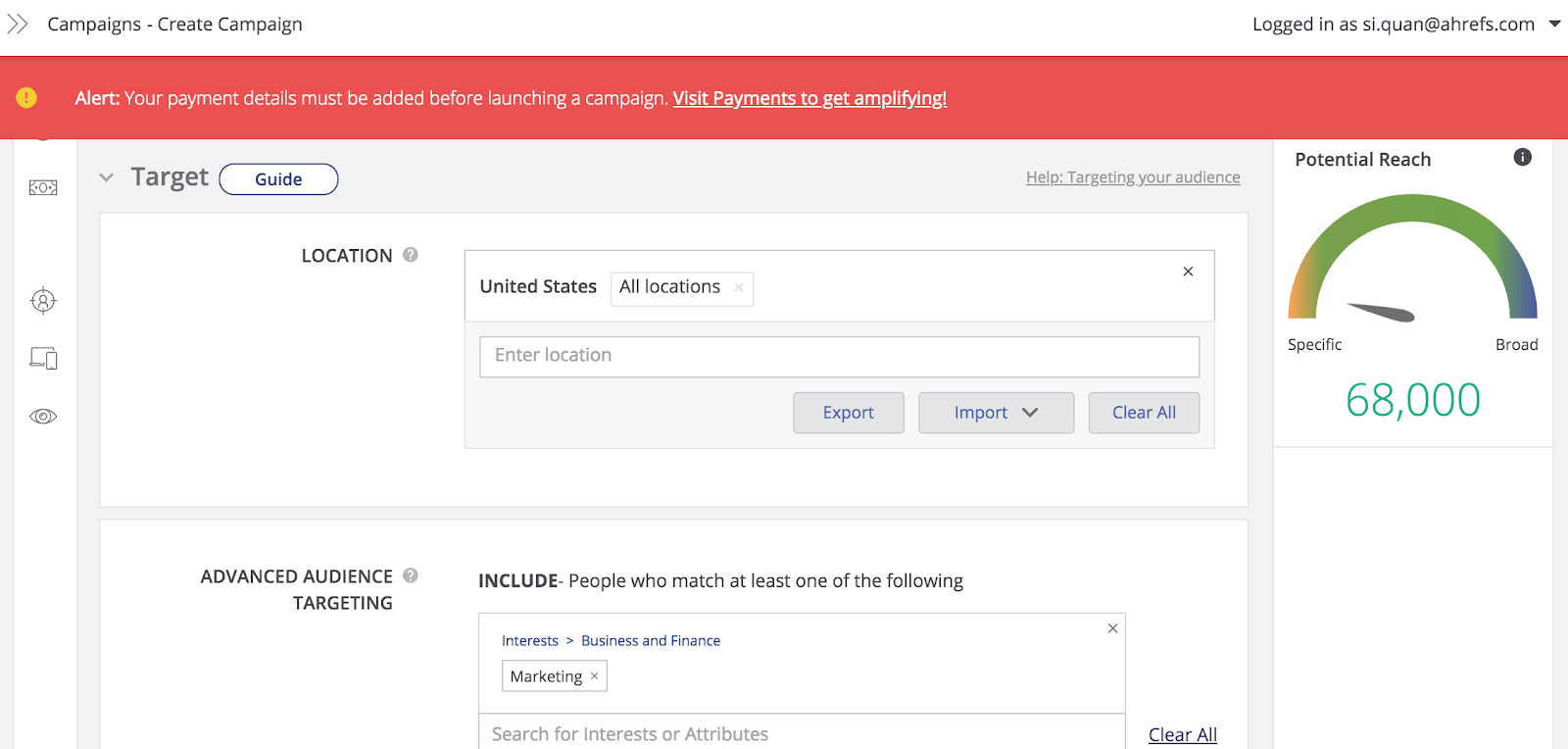
Self-syndication
Self-syndication is where you republish your content on other websites yourself.
There are a few places where you can do this:
A. Medium
Medium is a popular online publication where anyone can contribute. It gets an estimated 39 million monthly visits from organic search alone.

But you don’t have to publish new content here; you can syndicate existing content.
To do this, click on your profile picture and go to Stories > Import a story > Paste in the URL

Everything gets imported in seconds, complete with images and formatting. Medium also adds a canonical link back to the original.
B. LinkedIn
While you can share a direct link to your post on the platform, you might get more eyeballs on your content by republishing directly on LinkedIn.
To do this, click “Write an article” and copy-paste your content:

When I did this previously for my articles, it got a decent number of views:

C. Reddit
Reddit is another popular place where anyone can post. The problem is that users don’t take kindly to blatant self-promotion.
With that in mind, your best bet is to republish your post word for word on a relevant subreddit, then link to the source at the end.

Don’t try to shoehorn promotional or affiliate links—that’s a surefire way to get banned.
You’re not limited to only syndicating to other sites to promote your content. Since it takes time and effort to create an outstanding article, you should work to make each piece go the extra mile.
There are two ways to do this: reformatting or splintering.
Reformatting
Reformatting means turning your article into a new format, such as a video or podcast.
There are two reasons to do this:
- Since not everyone wants to read, you can reach a wider audience of people who prefer to watch or listen.
- New formats mean new syndication opportunities. For example, you can syndicate videos to YouTube and Facebook, and podcasts to Soundcloud, Spotify, and Google Podcasts.
Splintering
A single article can contain tons of unique, individual tips. Extract these “soundbites” and re-use them elsewhere.
For example, we regularly turn our unique images into “snackable” tips on Twitter:
How many web pages get organic search traffic?
We took the entire database from our Content Explorer tool (over one billion pages) and studied how many pages get traffic from organic search.
Here are the results. pic.twitter.com/ouwpJuoFOF— Ahrefs (@ahrefs) February 10, 2020
And since we already reformat our articles into videos, we also go further by splintering the videos into bite-sized versions that we re-post on Twitter:
Keyword research tip: find keywords forums are ranking for
Forums with high search traffic, especially the niche relevant ones, are a goldmine for keyword ideas. pic.twitter.com/FVAbTfHVFu— Ahrefs (@ahrefs) February 18, 2020
Want to extract even more value?
Blow out these “mini ideas” into unique guest posts, which you can then pitch to other sites.
The possibilities are endless. All you need is a little creativity.
If you want more ideas for splintering and repurposing content, read this post to see how GaryVee does it.
Final thoughts
If you’ve spent time creating a great piece of content, don’t neglect it after hitting “publish.”
Instead, syndicate your content to reach new audiences on other platforms and publications, and to increase brand awareness.
Did we miss anything important in this guide? Let me know on Twitter.




